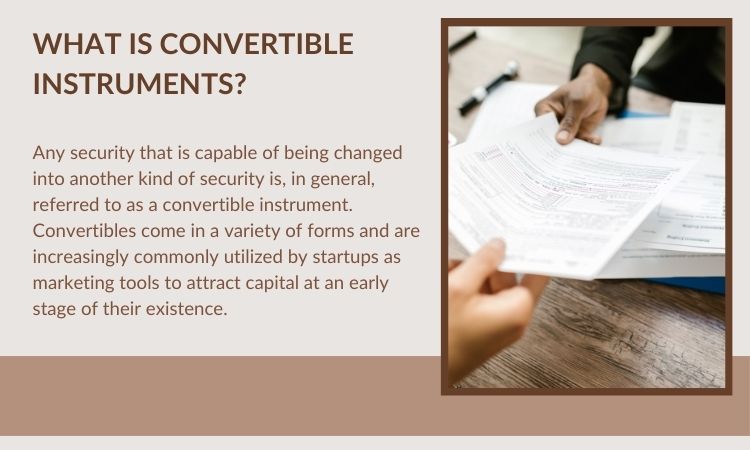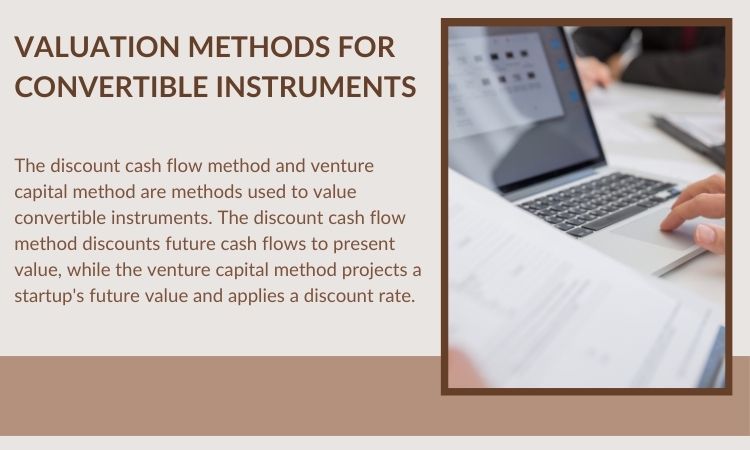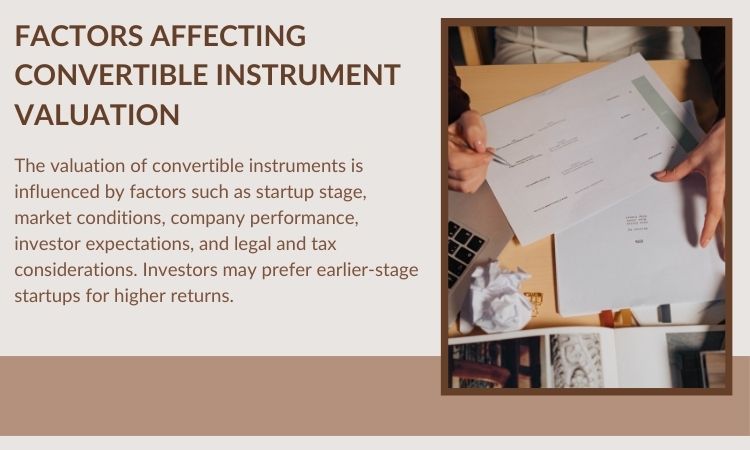Convertible instruments have become a staple in early-stage funding, offering a flexible and risk-mitigating approach for both startups and investors. These instruments, such as convertible notes and Simple Agreements for Future Equity (SAFEs), provide a bridge between debt and equity financing, allowing startups to raise capital without immediately determining their valuation. Accurate valuation of convertible instruments is essential for fair deals, future equity dilution, and investor confidence.
In this blog post, we will explore various convertible valuation strategies tailored for startups. By understanding these strategies, startups can make informed decisions, negotiate favourable terms, and set the stage for future growth.
Table of Contents
ToggleUnderstanding Convertible Instruments
Convertible instruments are unique financial instruments that offer a hybrid of debt and equity features. Usually, they consist of the following essential elements:
- Conversion Price: The amount that can be used to convert a convertible instrument into equity shares.
- Discount: When the instrument converts into equity, investors receive a premium since a discount is applied to the conversion price.
- Cap: A maximum valuation at which the convertible instrument can convert into equity, protecting investors from excessive dilution.

How Convertible Instruments Differ from Traditional Equity Financing
Unlike traditional equity financing, where investors purchase equity shares directly, convertible instruments provide a more flexible structure. They offer the following advantages:
- Deferred Valuation: Startups can lower their risk of undervaluation by delaying their valuation to a subsequent fundraising round via convertible instruments.
- Lower Risk for Investors: Investors can participate in the startup’s potential upside without taking on immediate equity risk.
- Faster Funding: Convertible instruments can often be negotiated and closed more quickly than traditional equity rounds.
Benefits of Using Convertible Instruments for Startups
- Flexibility: Convertible instruments offer startups flexibility in terms of valuation, fundraising timing, and future equity dilution.
- Reduced Dilution: By deferring valuation, startups can potentially minimize equity dilution in future funding rounds.
- Access to Capital: Convertible instruments can provide startups with access to capital when traditional equity financing may be challenging to obtain.
Drawbacks of Using Convertible Instruments for Startups
- Potential for Dilution: While convertible instruments can reduce dilution in early-stage funding, excessive dilution may occur if the startup’s valuation increases significantly before conversion.
- Complexity: The terms and conditions of convertible instruments can be complex, requiring careful negotiation and understanding.
- Limited Control: Investors holding convertible instruments may have limited control over the startup’s operations compared to equity shareholders.
Valuation Methods for Convertible Instruments
1. Discount Cash Flow Method
The discount cash flow method is a common approach for valuing convertible instruments. It involves discounting the future cash flows expected from the instrument to their present value using a specified discount rate.
Factors Affecting the Discount Rate Selection:
- Risk-Free Rate: An investment that has no risk, like US Treasury bonds, has an interest rate.
- Startup Risk: The perceived risk of the startup, including factors like industry competition, management team, and market potential.
- Market Conditions: The overall economic environment and market sentiment.
Calculating Valuation Using the Discount Rate Method:
- Estimate future cash flows: Project the expected cash flows from the convertible instrument, considering factors like conversion probability, conversion price, and potential equity value.
- Determine the discount rate: Based on the previously listed considerations, choose a suitable discount rate.
- Discount cash flows: Using the discount rate, determine the present value of each future cash flow.
- Sum the present values: To get the total valuation, add together the present values of all future cash flows.

2. Venture Capital Method
The venture capital method is a simplified approach that is commonly used in the venture capital industry. Projecting the startup’s future value and applying a discount rate to get the present value are the steps in the procedure.
Underlying Assumptions:
- Future Value: The venture capital method assumes that the startup will achieve a certain future value based on its growth potential and market conditions.
- Discount Rate: To account for the opportunity cost and risk of the investment, a discount rate is used.
Considerations for the Venture Capital Method's Factors:
- Startup Potential: The startup’s industry, market size, competitive advantage, and management team.
- Comparable Company Analysis: Contrasting the startup with comparable openly traded firms.
- Precedent Transaction Analysis: Analyzing recent transactions involving similar startups.
Calculating Valuation Using the Venture Capital Method:
- Estimate future value: Project the startup’s future value based on various factors, such as revenue growth, profitability, and market share.
- Determine the discount rate: Select an appropriate discount rate based on the startup’s risk profile and market conditions.
- Calculate present value: Using the discount rate, reduce the future value to the present.
Factors Affecting Convertible Instrument Valuation
1. Startup Stage
The stage of the startup significantly impacts convertible instrument valuation. Earlier-stage startups (seed, pre-seed) typically have higher risk profiles and require a higher discount rate, resulting in lower valuations. As startups progress to later stages (series A, series B), their valuations generally increase due to reduced risk and increased traction.
2. Market Conditions
Broader market trends and economic factors can influence convertible instrument valuation. During periods of economic growth and investor optimism, valuations may be higher. In contrast, values could be lower amid market turbulence or economic downturns.
3. Company Performance
A startup’s financial performance and growth prospects are key determinants of valuation. Strong revenue growth, profitability, and market share can lead to higher valuations. Conversely, poor financial performance or lack of growth potential can result in lower valuations.

4. Investor Expectations
Investor preferences and risk appetite can also influence convertible instrument valuation. Investors seeking high returns may be willing to accept higher risk and invest in earlier-stage startups at lower valuations. Conversely, investors with a more conservative approach may prefer later-stage startups with lower risk and higher valuations.
5. Legal and Tax Considerations
Legal and tax factors can have implications for convertible instrument valuation. For example, the jurisdiction in which the startup is incorporated may have specific laws governing convertible instruments, which can affect their valuation. Additionally, tax implications, such as capital gains taxes or income taxes, should be considered when evaluating the overall value of the instrument.
Best Practices for Convertible Valuation
1. Engage with Qualified Professionals
Valuing convertible instruments can be complex, requiring specialized knowledge and expertise. It is highly recommended to engage with qualified valuation professionals who have experience in this area. They may assist in negotiating the difficulties of convertible instrument value, guarantee accurate appraisals, and offer insightful advice.
2. Document the Valuation Process
Maintaining a detailed record of the valuation process is essential for several reasons. It can serve as a reference for future negotiations, provide transparency to investors, and help in case of disputes. The documentation should include the valuation methodology used, assumptions made, data sources, and any supporting evidence.
3. Consider Sensitivity Analysis
Conducting sensitivity analysis can provide valuable insights into the potential impact of different scenarios on the valuation. By varying key assumptions, such as future revenue growth, market size, or discount rate, startups can assess how changes in these factors can affect the valuation. Making informed decisions can be aided by this analysis’s ability to pinpoint possible risks and possibilities.
4. Stay Updated on Industry Trends
The landscape of convertible instruments and valuation methodologies is constantly evolving. It is important to stay updated on the latest developments, industry trends, and best practices. This can be achieved through industry publications, conferences, and networking with valuation professionals. By staying informed, startups can ensure that their valuation approaches are aligned with current market standards and practices.

Conclusion
Accurate valuation of convertible instruments is crucial for startups seeking funding and investors looking to make informed decisions. By understanding the various valuation methods, factors affecting valuation, and best practices, startups can navigate the complexities of convertible financing and negotiate favourable terms.
Marcken Consulting is a leading provider of valuation services, specializing in convertible instrument valuation. Our team of experienced professionals can assist startups in conducting comprehensive valuations, ensuring accurate and reliable results.
Frequently Asked Questions
Q1. What distinguishes a convertible note from a SAFE (Simple Agreement for Future Equity)?
Convertible notes and SAFEs are both hybrid debt-equity instruments used in early-stage funding. However, they have key differences:
- Interest: Convertible notes typically accrue interest, while SAFEs do not.
- Discount: Convertible notes often include a discount on the conversion price, while SAFEs may have a valuation cap or discount rate.
- Priority: Convertible notes generally have a higher priority than SAFEs in the event of liquidation.
Q2. What effect does a startup's stage have on its valuation?
Earlier-stage startups (seed, pre-seed) typically have higher risk profiles and require a higher discount rate, resulting in lower valuations. As startups progress to later stages (series A, series B), their valuations generally increase due to reduced risk and increased traction.
Q3. Can a startup renegotiate the terms of a convertible instrument?
In some cases, startups may be able to renegotiate the terms of a convertible instrument, particularly if the market conditions or the startup’s performance have changed significantly since the initial agreement. However, renegotiation can be challenging and may require careful negotiation with investors.


